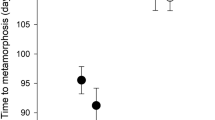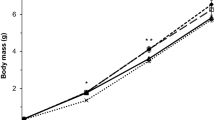Abstract
The axolotl (Ambystoma mexicanum) is a critically endangered and threatened species endemic of the Central Valley of Mexico. The population of this neotenic amphibian has declined in recent years as a result of habitat destruction, polluted waters, and the introduction of exotic species such as tilapia. We evaluated the antipredator response of predator-naïve axolotls to visual and chemical cues of the Nile tilapia (Oreochromis niloticus) and its foraging consequences. Axolotls decreased their activity and increased their use of refuge in the presence of combined chemical and visual cues from the predator. The axolotls seem to use their vision to confirm the level of risk perceived through chemical signals to modulate their antipredator response accordingly. The axolotls engaged in prey capture at a similar rate independent of the type of predator exposure. However, the efficiency of prey capture decreased in axolotls exposed to the chemical and the combined visual and chemical cues from the tilapia. The foraging costs to the axolotls induced by tilapia can ultimately affect their growth rate and size. The axolotls display antipredator behaviours to reduce the risk of predation by tilapia, which is a primary condition of coexistence with this exotic predator.


Similar content being viewed by others
References
Álvarez del Villar, J. & L. Navarro, 1957. Los peces del Valle de México. Secretaría de Marina. Instituto Nacional de la Pesca e Industrias Conexas: 3–22.
Amo, L., P. López & J. Martín, 2004. Wall lizards combine chemical and visual cues of ambush snake predators to avoid overestimating risk inside refuges. Animal Behaviour 67: 647–653.
Anver, M. R. & C. L. Pond, 1984. Biology and diseases of amphibians. In Fox, J. G., B. J. Cohen & F. M. Loew (eds), Laboratory Animal Medicine. Academic Press, New York: 427–447.
Armstrong, J. B., S. T. Duhon & G. M. Malacinski, 1989. Raising the axolotl in captivity. In Armstrong, J. B. & G. M. Malacinsky (eds), Developmental Biology of the Axolotl. Oxford University Press, New York: 220–227.
Blancas-Arroyo, A. G., G. Figueroa-Lucero, I. A. Barriga-Sosa & J. L. Arredondo, 2003. Aportaciones al cultivo controlado del pez blanco, Chirostoma humboldtianum, Valenciennes 1835 (Pisces: Atherinopsidae). In Rojas, C. P. M. & C. D. Fuentes (eds), Historia y Avances del Cultivo de Pescado blanco. Instituto Nacional de la Pesca, SAGARPA, México, D.F. [available on internet at http://www.inapesca.gob.mx/portal/documentos/publicaciones/LIBROS/pescado_blanco.pdf].
Chivers, D. P., J. M. Kiesecker, M. T. Anderson, E. L. Wildy & A. R. Blaustein, 1996. Avoidance response of terrestrial salamander (Ambystoma macrodactylum) to chemical alarm cues. Journal of Chemical Ecology 22: 1709–1716.
Chivers, D. P. & R. J. F. Smith, 1998. Chemical alarm signalling in aquatic predator/prey systems: a review and prospectus. Ecoscience 5: 338–352.
Contreras, V., E. Martínez-Meyer, E. Valiente & L. Zambrano, 2009. Recent decline and potential distribution in the last remnant area of the microendemic Mexican axolotl (Ambystoma mexicanum). Biological Conservation 142: 2881–2885.
DOF-Diario Oficial de la Federación, 2010. Norma Oficial Mexicana NOM-059-SEMARNAT-2010. Protección Ambiental Especies Nativas de México de Flora y Fauna Silvestres Categorías de Riesgo y Especificaciones para su Inclusión, Exclusión o Cambio Lista de Especies en Riesgo. Diario Oficial de la Federación, México.
Eisthen, H. L. & D. Park, 2005. Chemical signals and vomeronasal system function in axolotl (Ambystoma mexicanum). In Mason, R., M. LeMaster & D. Müller-Schwarze (eds), Chemical Signals in Vertebrates. Springer, New York: 216–227.
Ferrari, M. C. O., A. Gonzalo, F. Messier & D. P. Chivers, 2007. Generalization of learned predator recognition: an experimental test and framework for future studies. Proceedings of the Royal Society, Biological Sciences 274:1853–1859.
Fessehaye, Y., A. Kabir, H. Bovenhuis & H. Komen, 2006. Prediction of cannibalism in juvenile Oreochromis niloticus based on predator to prey weight ratio, and effects of age and stocking density. Aquaculture 255: 314–322.
Fitzpatrick, B. M., M. F. Benard & J. A. Fordyce, 2003. Morphology and escape performance of tiger salamander larvae (Ambystoma tigrinum mavortium). Journal of Experimental Zoology 2797A: 147–159.
Fitzsimmons, K., 2000. Tilapia aquaculture in Mexico. In Costa-Pierce, B. A. & J. E. Rakocy (eds), Tilapia Aquaculture in the Americas, Vol. 2. The World Aquaculture Society, Baton Rouge: 171–183.
Fortes, R. S., F. J. Martínez, M. Villarroel & F. J. Sánchez-Vázquez, 2010. Daily feeding patterns and self-selection of dietary oil in Nile tilapia. Aquaculture Research 42: 157–160.
Ghirlanda, S. & M. Enquist, 2003. A century of generalisation. Animal Behavior 66: 15–36.
Gonzálo, A., P. López & J. Martín, 2007. Iberian green frog tadpoles may learn to recognize novel predators from chemical alarm cues of conspecifics. Animal Behavior 74: 447–453.
Graue, W. V., 1998. Estudio genético y demográfico de la población del anfibio Ambystoma mexicanum (Caudata: Ambystomidae) del Lago de Xochimilco. Instituto de Ciencias del Mar y Limnología, Universidad Nacional Autónoma de México, México.
Hartman, E. J. & M. V. Abrahams, 2000. Sensory compensation and the detection of predators: the interaction between chemical and visual information. Proceedings of the Royal Society, Biological Sciences 267: 571–575.
Hickman, C. R., M. D. Stone & A. Mathis, 2004. Priority use of chemical over visual cues for detection of predators by graybelly salamanders Eurycea multiplicata griseogaster. Herpetologica 60: 203–210.
IUCN, 2014. The IUCN Red List of Threatened Species [available on internet at http://www.iucnredlist.org].
Jara, F. & M. Perotti, 2010. Risk of predation and behavioural response in three anuran species: influence of tadpole size and predator type. Hydrobiologia 644: 313–324.
Johnson, E., P. Bierzychudek & H. Whiteman, 2003. Potential of prey size and type to affect foraging asymmetries in tiger salamander (Ambystoma tigrinum nebulosum) larvae. Canadian Journal of Zoology 81: 1726–1735.
Kats, L. B. & L. M. Dill, 1998. The scent of death: chemo-sensory assessment of predation risk by prey animals. Ecoscience 5: 361–394.
Kats, L. B. & R. P. Ferrer, 2003. Alien predators and amphibian declines: review of two decades of science and the transition to conservation. Diversity and Distribution 9: 99–110.
Kelley, J. L. & A. E. Magurran, 2003. Learned predator recognition and antipredator responses in fishes. Fish and Fisheries 4: 216–226.
Kerby, J. L., A. J. Hart & A. Storfer, 2011. Combined effect of virus, pesticide, and predator cue on the larval tiger salamander (Ambystoma tigrinum). EcoHealth 8: 46–54.
Kiesecker, J. M., 2003. Invasive species as a global problem: towards understanding the worldwide decline of amphibians. In Semlitsh, R. D. (ed), Amphibian Conservation. Smithsonian Press, Washington, DC: 113–126.
Knapp, R. A. & K. R. Matthews, 2000. Non-native fish introductions and the decline of the mountain yellow-legged frog from within protected areas. Conservation Biology 14: 428–438.
Landberg, T. & E. Azizi, 2010. Ontogeny of escape swimming performance in the spotted salamander. Functional Ecology 24: 576–587.
Lindquist, S. B. & M. D. Bachmann, 1982. The role of visual and olfactory cues in the prey catching behavior of the tiger salamander, Ambystoma tigrinum. Copeia 1982: 81–90.
Mathis, A. & F. Vincent, 2000. Differential use of visual and chemical cues in predator recognition and threat-sensitive predator-avoidance responses by larval newts (Notophthalmus viridescens). Canadian Journal of Zoology 78: 1646–1652.
Milinski, M. & Y. R. Heller, 1978. Influence of a predator on the optimal foraging of sticklebacks (Gasterosteus aculeatus L.). Nature 273: 642–644.
Mundy, B., 1997. Simple brine shrimp hatchery. In Duhon, S. T. (ed), Compendium of Axolotl Husbandry Methods. Axolotl Newsletter 25. Indiana University Axolotl Colony, Bloomington.
Münz, H. & B. Claas, 1991. Activity of lateral line efferent in the axolotl Ambystoma mexicanum. Journal of Comparative Physiology 169: 461–469.
Njiru, M., J. Okeyo-Owuor, J. Muchiri & G. Cowx, 2004. Shifts in the food of Nile tilapia, Oreochromis niloticus (L.) in Lake Victoria, Kenya. African Journal of Ecology 42: 163–170.
Nunes, A. L., G. Orizaola, A. Laurila & R. Rebelo, 2014. Rapid evolution of constitutive and inducible defenses against an invasive predator. Ecology 95: 1520–1530.
Pearson, K. J. & C. P. Goater, 2009. Effects of predaceous and nonpredaceous introduced fish on the survival, growth, and antipredation behaviours of long-toed salamanders. Canadian Journal of Zoology 87: 948–955.
Pease, K. M., 2011. Rapid evolution of anti-predator defenses in Pacific tree frog tadpoles exposed to invasive predatory crayfish. Doctoral dissertation. University of California, Los Angeles.
Pilliod, D. S., R. S. Arkle & B. A. Maxel, 2013. Persistence and extirpation in invaded landscapes: patch characteristics and connectivity determine effects of non-native predatory fish on native salamanders. Biological Invasions 15: 671–685.
Richardson, J. L., 2001. A comparative study of activity levels in larval anurans and response to the presence of different predators. Behavioral Ecology 12: 51–58.
Robles, M. M. B., 2011. Ritmo circadiano de actividad locomotriz en el ajolote mexicano juvenil Ambystoma mexicanum: sincronización y libre curso. Thesis, Facultad de Ciencias, Universidad Nacional Autónoma de México.
Robles-Mendoza, C., C. E. Basilio & R. C. P. Vanegas, 2009. Maintenance media for the axolotl Ambystoma mexicanum juveniles (Amphibia: Caudata). Hidrobiológica 19: 205–210.
Secor, S. M. & M. Boehm, 2006. Specific dynamic action of ambystomatid salamanders and the effects of meal size, meal type, and body temperature. Physiological and Biochemical Zoology 79: 720–735.
Semlitsch, R. D., 1987. Interactions between fish and salamander larvae. Cost of predator avoidance or competition? Oecologia 72: 481–486.
Sih, A., D. I. Bolnick, B. Luttbeg, J. L. Orrock, S. D. Peacor, L. M. Pintor, E. Preisser, J. S. Rehage & J. R. Vonesh, 2010. Predator-prey naïveté, antipredator behavior, and the ecology of predator invasions. Oikos 119: 610–621.
Skelly, D. K., 1992. Field evidence for a cost of behavioural antipredator response in a larval amphibian. Ecology 73: 704–708.
Skelly, D. K., 1994. Activity level and the susceptibility of anuran larvae to predation. Animal Behaviour 47: 465–468.
Stauffer, H. P. & R. D. Semlitsch, 1993. Effects of visual, chemical and tactile cues of fish on the behavioural responses of tadpoles. Animal Behaviour 46: 355–364.
Trujillo-Jiménez, P. & E. V. Espinosa de los Monteros, 2006. La ecología alimentaria del pez endémico Girardinichthys multiradiatus (Cyprinidontiformes: Goodeidae) en el Parque Nacional Lagunas de Zempoala, México. Revista de Biología Tropical 54: 1247–1255.
Valiente, R. E. L, 2006. Efecto de las especies introducidas en Xochimilco para la rehabilitación del hábitat del ajolote (Ambystoma mexicanum). Thesis, Posgrado en Ciencias Biológicas, Universidad Nacional Autónoma de México, México.
Vera, L. M., L. Cairns, F. J. Sánchez-Vázquez & H. Migaud, 2009. Circadian rhythms of locomotor activity in the Nile tilapia Oreochromis niloticus. Chronobiology International 26: 666–681.
Walls, S. C., 1995. Differential vulnerability to predation and refuge use in competing larval salamanders. Oecologia 101: 86–93.
Werner, E. & B. Anholt, 1993. Ecological consequences of the trade-off between growth and mortality rates mediated by foraging activity. American Naturalist 142: 242–272.
Ydenberg, R. C. & L. M. Dill, 1986. The economics of fleeing from predators. Advances in the Study of Behavior 16: 229–249.
Zambrano, L., V. Contreras, M. Mazari-Hiriart & A. Zarco-Arista, 2009. Spatial heterogeneity of water quality in a highly degraded tropical freshwater ecosystem. Environmental Management 43: 249–263.
Zambrano, L., E. Valiente & M. J. Zanden, 2010. Food web overlap among native axolotl (Ambystoma mexicanum) and two exotic fishes: carp (Cyprinus carpio) and tilapia (Oreochromis niloticus) in Xochimilco, Mexico City. Biological Invasions 12: 3061–3069.
Zerba, K. E. & J. P. Collins, 1992. Spatial heterogeneity and individual variation in diet of an aquatic top predator. Ecology 73: 268–279.
Acknowledgments
This research was funded by the Facultad de Ciencias, Universidad Nacional Autónoma de México, UNAM. We thank the staff of the vivarium of FES-Iztacala-UNAM for donating the axolotls and Karla Kruesi Cortés for assistance during the experiments.
Author information
Authors and Affiliations
Corresponding author
Additional information
Handling editor: Lee B. Kats
Rights and permissions
About this article
Cite this article
Alcaraz, G., López-Portela, X. & Robles-Mendoza, C. Response of a native endangered axolotl, Ambystoma mexicanum (Amphibia), to exotic fish predator. Hydrobiologia 753, 73–80 (2015). https://doi.org/10.1007/s10750-015-2194-4
Received:
Revised:
Accepted:
Published:
Issue Date:
DOI: https://doi.org/10.1007/s10750-015-2194-4




